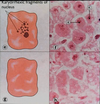Cell and Tissue Injury Flashcards
Four causes of cell atrophy
1) Loss of blood supply or innervation 2) Loss of endocrine factors 3) Decrease in the workload 4) Aging or chronic illness.
Three examples of reversible cell injury
1) Cell swelling - reversible once membrane function is restored. 2) Increases in extracellular metabolites - huge glycogen stores in liver of diabetics due to uncontrolled blood sugar, reverses once blood sugar is controlled and gycogen is released from liver cells to blood. 3) Fatty change in liver - vacuoles of fat appear in liver after many types of injury.
What are four primary vulnerable sites on a cell?
Cell membrane, mitochondria, endoplasmic reticulum, and nucleus.
What are early morphological signs of cell damage, and what helps cells recover from early damage?
Swollen cells (membrane damage -> dec. pump function -> Na, H2O influx). Swollen mitochondria (leads to dec in ATP, damage to mmbr). Swollen rough ER, loss of mmbr bound ribosomes. Heat shock proteins help renature proteins and return normal cell function.
Two types of cell adaptation to injury
1) Hypertrophy - cells increase in size (eg, cardiac hypertrophy) 2) Atrophy - cell decreases in size due to loss of cell substance.
How does cell injury lead to disease?
Cell injury perturbs cell physiology, and the cell does not function at full capacity.
What are some examples of how anatomical relationships and the tissue tropism of chemical and infectious agents lead to disease?
The sharp turns of the coronary arteries leads to turbulent blood flow and the deposition of plaques on the corners. Tissue tropism is illustrated by hepatic infections attacking liver cells due to their affinity for the receptors on those cells.
What are the four basic types of tissue and which is most commonly injured in disease?
Epithelium, muscle, nerve, and connective tissue. Epithelium is by far the most commonly damaged in disease, about 90% of all diseases are diseases of the epithelium.
What are the three principles of pathology?
1) Human disease occurs because of injury to cells/tissue 2) Most human disease results from injury to the epithelium 3) Injury to one tissue affects the adjacent or underlying tissue as well.
What are the timeframes associated with acute and chronic injuries, and how to pathologists differentiate them?
Acute is hours to a few days, chronic is days to months. Pathologists differentiate them based on the types of immune cells present (the inflammatory infiltrate): PMNs in acute injury, plasma cells and lymphocytes in chronic injury.
What is a consequence of the third principle of pathology?
Damage to one layer, typically epithelium, leads to damage of deeper tissues. Thus, a stomach ulcer will cause damage to the connective tissue of the submucosa as it is exposed to gastric juices. This may eventually lead to damage of the pancreas or peritoneum as the injury spreads deeper.
What is an example of cell/tissue adaptation to disease?
Hypertophy of cardiac muscle cells. Cardiac muscle cells adapt to long term high blood pressure by increasing their size, which produces more force to push the blood around.

What is an ulcer?
A ulcer means there is destruction of the mucosa, exposing the sub-mucosa to the outside space.
What is caseous necrosis?
Seen within infected tisssues (often TB) where cells are characterized as soft, friable, whitish-grey. Resembles the milk protein casein (hence caseous).
What is coagulative necrosis?
The dead cell remains in place, as a ghost-like remnant of its former self. Often seen in MIs.
What is fat necrosis?
The leakage of lipases from dead cells attack triglycerides in the surrounding fat tissue and generate free fatty acids and calcium soaps. Soaps have chalky-white appearance. Seen in the pancrease after acute inflammation.
What is karyorrhexis?
The fragmentation of the pyknotic nucleus.

What is karyolysis?
Extensive hydrolysis of the pyknotic nucleus with loss of staining. Represents breakdown of the denatured chromatin.

What is liquefactive necrosis?
The dead cell undergoes extensive autolysis, caused by the release of lysosomal hydrolases (proteinases, DNAses, RNAses, etc.) from lysosomes. Seen classically in the spleen and brain following infarction. Contents of cell are liquified.
What is pyknosis?
An intensely dark staining and shrunken nucleus seen in necrotic cells.
What four parameters do the outcomes of cell injury depend upon?
1) Type of injury 2) Severity of the injury 3) Duration of the damage 4) Type of cell being damaged (Some cells sustain damage better than others, and some tissues have the ability to regenerate (e.g., liver))
What is the general process of liver cirrhosis?
Heavy alcohol use leads to scarring of the liver cells, which impedes their ability to function properly. Scar tissue is visible in the liver, where it begins building around the portal triads and moves towards the central veins. The lobular architecture is distorted and liver function is impacted. This results from repeated bouts of alcoholic hepatitis.
What signals may lead to hypertrophy in cardiac cells? Of the uterus? Of the prostate?
Cardiac: a-andrenergic hormones, Angiotensin II, Endothelin, growth factors, and mechanical stretch receptors. Uterus: estrogen/pregnancy. Prostate: 5-hydroxtestosterone.

What three observable or reportable things does cell injury produce?
1) Signs: the abnormal physical findings that the physician observes. 2) Symptoms: the complaints experienced by the patient. 3) Morphological change: a visible change in the cell shape or appearance, visible by microscopy, staining, or the naked eye.



